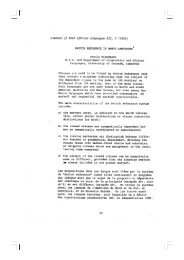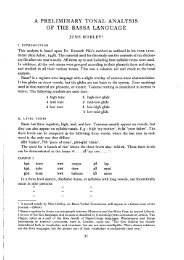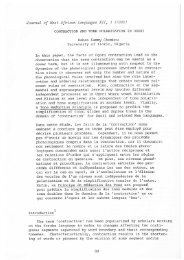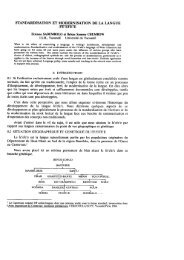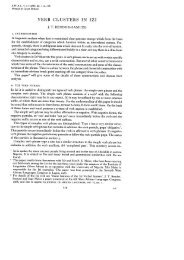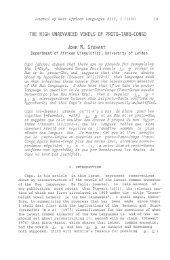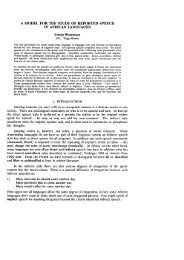The floating low tone in Bantu - Journal of West African Languages
The floating low tone in Bantu - Journal of West African Languages
The floating low tone in Bantu - Journal of West African Languages
You also want an ePaper? Increase the reach of your titles
YUMPU automatically turns print PDFs into web optimized ePapers that Google loves.
$$<br />
10 <strong>Journal</strong> <strong>of</strong> <strong>West</strong> <strong>African</strong> <strong>Languages</strong> XXXI.1 (2004)<br />
Default L Insertion nkuu ats<br />
L H L L<br />
SR [nkuu] [ats]<br />
<strong>The</strong> default rule <strong>in</strong>sertion is stated <strong>in</strong> 8c be<strong>low</strong>.<br />
(8) c. V<br />
L<br />
It has been assumed <strong>in</strong> this paper that there is a <strong>float<strong>in</strong>g</strong> <strong>low</strong> <strong>tone</strong> that triggers the<br />
formation <strong>of</strong> a fall<strong>in</strong>g <strong>tone</strong>. This has been done without present<strong>in</strong>g any empirical<br />
evidence for mak<strong>in</strong>g this assumption. In the next section we present the basis on which<br />
our assumption is founded.<br />
<strong>The</strong> evidence to prove that a <strong>float<strong>in</strong>g</strong> <strong>low</strong> <strong>tone</strong> is the cause <strong>of</strong> the fall<strong>in</strong>g <strong>tone</strong><br />
formation can be found <strong>in</strong> the process <strong>of</strong> negative noun formation <strong>in</strong> the language.<br />
In Bafut, there are nouns that are derived from verbs, and other nouns by<br />
prefix<strong>in</strong>g the negative morpheme t which means “One who does not”. Examples are<br />
presented <strong>in</strong> 9 be<strong>low</strong>.<br />
(9) a. (i) kx$ $ run tkx 10 one who does not run<br />
(ii) j see tj one who does not see<br />
b. (i) atu head ttu one who does not have a head<br />
(ii) ndoo husband tndoo one who does not have a husband<br />
In 9, we have formed nouns by prefix<strong>in</strong>g the negative morpheme t to verbs <strong>in</strong><br />
9a, and nouns <strong>in</strong> 9b. In 9a the roots have no <strong>in</strong>itial vowels or syllabic nasals while the<br />
roots <strong>in</strong> 9b beg<strong>in</strong> <strong>in</strong> a vowel as <strong>in</strong> 9b (i) and a syllabic nasal as <strong>in</strong> 9b (ii). When the<br />
negative morpheme is prefixed <strong>in</strong> 9b, V-deletion and desyllabification apply. Watch<br />
how these nouns will behave <strong>in</strong> relation to HTS illustrated <strong>in</strong> 10.<br />
(10) a. (i) /fa t kx/ [fatkx] give one who does not run<br />
(ii) / fa tj/ [fatj] give one who does not see<br />
b. (i) / fa ttu/ [fattu] give one who does not have a head<br />
(ii) / fa tndoo/ [fatndoo] give one who does not have a husband<br />
As it is the case with nom<strong>in</strong>al prefixes, we also assume here that the negative marker<br />
t- is also <strong>tone</strong>less.<br />
10 This noun is formed from a <strong>low</strong> <strong>tone</strong> class verb whereas the noun <strong>in</strong> 9a(ii) is formed from a high <strong>tone</strong><br />
class verb. Low <strong>tone</strong> verbs <strong>in</strong> this language are believed to have a LH tonal melody and it is a typical<br />
characteristic <strong>of</strong> nouns derived from verbs <strong>of</strong> this class to lose the high <strong>tone</strong> <strong>in</strong> their nom<strong>in</strong>al form. This<br />
accounts for the reason why it surfaces with a <strong>low</strong> <strong>tone</strong>.



